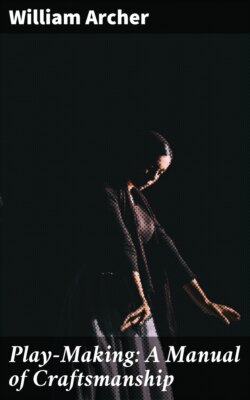Play-Making: A Manual of Craftsmanship

Реклама. ООО «ЛитРес», ИНН: 7719571260.
Оглавление
Archer William. Play-Making: A Manual of Craftsmanship
Play-Making: A Manual of Craftsmanship
Table of Contents
BOOK I
CHAPTER I
CHAPTER II
CHAPTER III
CHAPTER IV
CHAPTER V
BOOK II
CHAPTER VI
CHAPTER VII
CHAPTER VIII
CHAPTER IX
CHAPTER X
BOOK III
CHAPTER XI
CHAPTER XII
CHAPTER XIII
CHAPTER XIV
CHAPTER XV
CHAPTER XVI
CHAPTER XVII>
BOOK IV
CHAPTER XVIII
CHAPTER XIX
CHAPTER XX
CHAPTER XXI
BOOK V
CHAPTER XXII
CHAPTER XXIII
Отрывок из книги
William Archer
Published by Good Press, 2019
.....
The champions of the theory, moreover, place it on a metaphysical basis, finding in the will the essence of human personality, and therefore of the art which shows human personality raised to its highest power. It seems unnecessary, however, to apply to Schopenhauer for an explanation of whatever validity the theory may possess. For a sufficient account of the matter, we need go no further than the simple psychological observation that human nature loves a fight, whether it be with clubs or with swords, with tongues or with brains. One of the earliest forms of mediaeval drama was the "estrif" or "flyting"--the scolding-match between husband and wife, or between two rustic gossips. This motive is glorified in the quarrel between Brutus and Cassius, degraded in the patter of two "knockabout comedians." Certainly there is nothing more telling in drama than a piece of "cut-and-thrust" dialogue after the fashion of the ancient "stichomythia." When a whole theme involving conflict, or even a single scene of the nature described as a "passage-at-arms," comes naturally in the playwright's way, by all means let him seize the opportunity. But do not let him reject a theme or scene as undramatic merely because it has no room for a clash of warring wills.
There is a variant of the "conflict" theory which underlines the word "obstacles" in the above-quoted dictum of Brunetière, and lays down the rule: "No obstacle, no drama." Though far from being universally valid, this form of the theory has a certain practical usefulness, and may well be borne in mind. Many a play would have remained unwritten if the author had asked himself, "Is there a sufficient obstacle between my two lovers?" or, in more general terms, "between my characters and the realization of their will?" There is nothing more futile than a play in which we feel that there is no real obstacle to the inevitable happy ending, and that the curtain might just as well fall in the middle of the first act as at the end of the third. Comedies abound (though they reach the stage only by accident) in which the obstacle between Corydon and Phyllis, between Lord Edwin and Lady Angelina, is not even a defect or peculiarity of character, but simply some trumpery misunderstanding[15] which can be kept afoot only so long as every one concerned holds his or her common sense in studious abeyance. "Pyramus and Thisbe without the wall" may be taken as the formula for the whole type of play. But even in plays of a much higher type, the author might often ask himself with advantage whether he could not strengthen his obstacle, and so accentuate the struggle which forms the matter of his play. Though conflict may not be essential to drama, yet, when you set forth to portray a struggle, you may as well make it as real and intense as possible.
.....